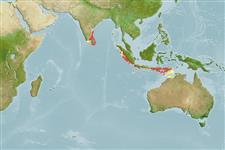>
Ovalentaria/misc (Various families in series Ovalentaria) >
Pseudochromidae (Dottybacks) > Pseudochrominae
Etymology: Pseudochromis: Greek, pseudes = false + Greek, chromis = a fish, perhaps a perch (Ref. 45335); tonozukai: Named for Takamasa Tonozuka.
Eponymy: Takamasa ‘Tono’ Tonozuka was a Japanese underwater photographer who was a long-term resident of Bali and co-owner of ‘Dive & Dive’. [...] (Ref. 128868), visit book page.
More on authors: Gill & Allen.
Environment: milieu / climate zone / rango de profundidad / distribution range
Ecología
marino asociado a arrecife; rango de profundidad 30 - 45 m (Ref. 90102). Tropical
Eastern Indian Ocean: Indonesia.
Tamaño / Peso / Age
Madurez: Lm ? range ? - ? cm
Max length : 6.3 cm SL macho / no sexado; (Ref. 56434); 6.6 cm SL (female)
Short description
Claves de identificación | Morfología | Morfometría
Espinas dorsales (total) : 3; Radios blandos dorsales (total) : 25; Espinas anales: 3; Radios blandos anales: 14 - 15. This species is diagnosed by the following characters: D III,25; A III,14-15; lateral line scales 34-36; caudal fin is rhomboid to trifurcate; no small dark spot on the upper part of pectoral fin (Ref. 56434).
Body shape (shape guide): elongated; Cross section: compressed.
Occurs at 45° slope with mixed sand-rubble substrate; at least four male-female pairs were observed, several were solitary (Ref. 56434).
Life cycle and mating behavior
Madurez | Reproducción | Puesta | Huevos | Fecundidad | Larva
Gill, A.C. and G.R. Allen, 2004. Pseudochromis lugubris and P. tonozukai, two new dottyback fish species from the Indo-Australian Archipelago (perciformes: Pseudochromidae: Pseudochrominae. Zootaxa 604:1-12. (Ref. 56434)
IUCN Red List Status (Ref. 130435: Version 2025-1)
Threat to humans
Harmless
Human uses
Herramientas
Special reports
Download XML
Fuentes de Internet
Estimates based on models
Phylogenetic diversity index (Referencia
82804): PD
50 = 0.5000 [Uniqueness, from 0.5 = low to 2.0 = high].
Bayesian length-weight: a=0.00501 (0.00193 - 0.01299), b=3.10 (2.88 - 3.32), in cm total length, based on LWR estimates for this (Sub)family-body shape (Ref.
93245).
Nivel trófico (Referencia
69278): 3.5 ±0.5 se; based on size and trophs of closest relatives
Fishing Vulnerability (Ref.
59153): Low vulnerability (10 of 100).
🛈
